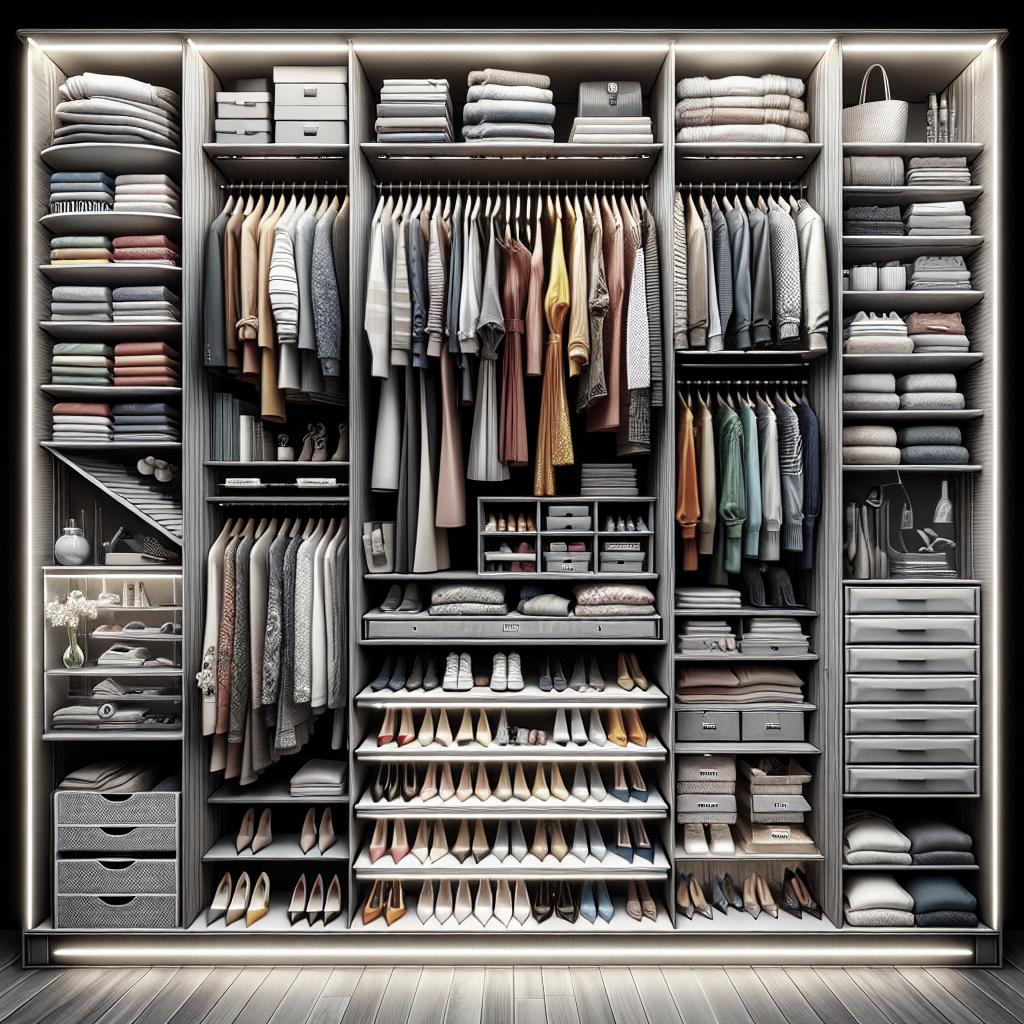“`html
How to Organize Your Wardrobe for Easier Styling
Crafting the perfect wardrobe isn’t just about the clothes you own but how you organize them. A well-organized wardrobe can make daily dressing a hassle-free and enjoyable process. Whether you have a closet fit for a fashionista or a more modest space, knowing how to systematically sort, categorize, and store your garments can lead to easier styling. This guide explores various strategies to declutter and systematize your wardrobe for peak efficiency. By examining principles such as dividing clothes by category or using over-the-door solutions, you can transform the way you interact with your closet—resulting in less time spent searching and more time looking effortlessly chic. Learn actionable tips like editing your wardrobe, storing seasonal outfits, and even coordinating children’s wardrobes.
1. Edit Your Wardrobe First
Before diving into new organizational methods, it’s essential to edit your wardrobe. This step involves a thorough decluttering session where you take stock of every piece you own. Begin by removing all items from your closet, laying them out where you can see them. Assess each garment for wear, fit, and how often you actually wear it. Be honest with yourself about pieces that no longer serve your style or lifestyle, as decluttering creates more space for what truly matters.
Consider donating items in good condition that you haven’t worn in over a year, or recycle textiles that are beyond repair. The goal here is to trim down to a curated collection of items you love and frequently use, making it easier to manage what you do keep. Creating donation boxes or scheduling a swap with friends can also make the process feel more rewarding and less wasteful.
2. Organize Garments Like Sweaters and Jeans in Plain Sight
Once you’ve edited your wardrobe, the next step is organizing key items like sweaters and jeans in an easily accessible manner. Visibility is crucial in styling; if you can’t see an item, you’re less likely to wear it. Use open shelving or clear storage bins to display these bulky items, keeping them neat yet visible. Arrange them by color or type to create a visually appealing and functional wardrobe component.
Utilizing vertical space is another clever solution. If your closet has adjustable shelving, try spacing shelves according to the height of folded clothes. This setup prevents piles from toppling over and allows you to quickly spot what’s available at a glance. Open storage solutions also serve as reminders of what you own, encouraging the use of a wider range of your wardrobe.
3. Divide Hanging Clothing by Category
A systematic approach to hanging clothing can revolutionize the ease of outfit selection. Divide your hanging items into categories such as long sleeves, short sleeves, formal wear, and outer garments. Not only does this method streamline your search for specific pieces, but it also keeps you aware of what you have in your collection.
To further enhance organization, consider color-coding within these categories. The visual arrangement helps in recognizing gaps in your wardrobe, facilitating more intentional shopping when replacing or adding new items. A streamlined hanging system can make getting dressed a quick and enjoyable activity, reducing time wasted searching for specific pieces.
4. Keep Your Best Attire on Wood Hangers
Quality hangers can greatly enhance the longevity and appearance of your clothing. Wood hangers are ideal for preserving the shape of items like blazers, coats, and dresses. Their sturdy build supports the weight of heavy garments, preventing stretching and fabric damage while also conveying an aesthetic of understated luxury.
Investing in uniform wooden hangers offers an additional benefit—it creates a cohesive look and minimizes visual clutter within the wardrobe. By maintaining uniformity, you can easily spot what stands out or feels out of place, contributing further to a curated and stylized wardrobe setup.
5. Install Over the Door Storage
If space is at premium, over-the-door storage can be a game-changer. These organizers, which can hang off a closet or room door, provide additional compartments for storing accessories like shoes, bags, scarves, or hats. This setup frees up precious closet space and makes good use of every available square inch.
Choose options with clear pockets to maintain visibility or opt for fabric that matches your decor for a more discreet look. Over-the-door storage isn’t just functional; it’s a customizable solution that adds convenience and accessibility to your daily routine.
6. Customize Closet Organization
One-size-fits-all is not always the most efficient approach to closet organization. Customizing your space can be crucial in maximizing storage and accessibility. Modular systems allow you to configure the components of your closet to fit your unique needs, whether it’s additional hanging space, shelving, or drawers.
Incorporate mix-and-match solutions like adjustable rods or create designated zones for various clothing types. Consider adding pull-out hampers or built-in shoe racks to manage laundry and footwear. Whatever personalized system you design, aim for functionality that caters to your personal wardrobe habits and style preferences.
7. Organize Seasonal Clothing Under the Bed
For items not currently in season, under-bed storage boxes offer a practical solution to keep them out of sight yet easily accessible for when their time comes around again. Invest in flat, wheeled containers that can store seasonal items like winter sweaters or summer shorts. This tactic not only declutters your main wardrobe but also extends its usability throughout the year.
Make sure stored garments are clean and packed in breathable fabric bags to prevent dust or odor buildup. Label these containers according to their contents or season for a more organized transition between clothing cycles. Efficient under-bed storage can relieve your closet from congestion while keeping everything within easy reach.
8. Plan Outfits on the Back of a Door
Use the back of a closet or bedroom door as a staging area to plan your outfits for the week. Outfit planning tools, such as door-mounted hooks or small hanging racks, can assist in organizing complete ensembles in advance, reducing decision fatigue every morning. This simple step can streamline your routine and increase creative styling.
For added convenience, attach a small bulletin board or chalkboard beside your outfit planner to note down accessory choices or notes on events and weather forecasts. This extra feature can turn a plain door into a multifunctional styling station.
9. Organize Clothes in a Freestanding Wardrobe
Not every home is equipped with built-in closets, and that’s where freestanding wardrobes come into play. These standalone units offer customizable storage solutions while also acting as design elements within a room. Choose a wardrobe that aligns with your aesthetic preferences and provides ample storage options like adjustable shelves and rods.
Freestanding wardrobes allow you to configure space according to your evolving needs. Adding drawer units or integrating baskets and bins can enhance functionality. With creative arrangement, these standalone closets can house everything from clothing and shoes to accessories, ensuring a neatly organized and aesthetically pleasing space.
10. Organize Clothes Storage for Kids
Children’s clothes, with their small sizes and frequent changes, can be challenging to manage. Creating a systematic storage plan tailored to young wardrobes involves ensuring accessibility and encouraging them to learn organization skills early. Place frequently worn items within their reach and use colorful bins or labels to simplify independent access.
Using low-hanging rods or garment bags can make selecting outfits easier for kids and teach them responsibility. Rotating clothes seasonally is also beneficial, storing out-of-season attire in higher shelving or away from daily rotation. Introducing child-friendly organization techniques helps cultivate tidiness and autonomy from a young age.
11. Stash Mending Tools Nearby
A well-kept wardrobe isn’t just about organization; it also involves maintenance. Keeping essential mending tools like needles, thread, spare buttons, or a sewing kit nearby can make minor repairs swift and convenient, prolonging the life of your clothes and preventing small issues from becoming major problems.
Designating a drawer or small box within your wardrobe or nearby workspace for these tools ensures accessibility when quick fixes are needed. Regularly maintaining your wardrobe items with minor touch-ups or adjustments helps sustain their quality and appearance, ensuring a stylish and organized closet remains at its best.
Next Steps
| Step | Action |
|---|---|
| Edit Your Wardrobe First | Declutter and donate, keeping only essentials. |
| Organize Garments Like Sweaters and Jeans in Plain Sight | Use open shelving or clear bins for visibility. |
| Divide Hanging Clothing by Category | Sort by type and color for easy access. |
| Keep Your Best Attire on Wood Hangers | Preserve shape and create uniformity. |
| Install Over the Door Storage | Maximize space with additional storage. |
| Customize Closet Organization | Use modular systems for tailored storage. |
| Organize Seasonal Clothing Under the Bed | Store non-seasonal items in containers. |
| Plan Outfits on the Back of a Door | Prepare and display outfits ahead of time. |
| Organize Clothes in a Freestanding Wardrobe | Use standalone units for flexible storage. |
| Organize Clothes Storage for Kids | Ensure accessibility and teach tidy habits. |
| Stash Mending Tools Nearby | Keep repair tools handy for garment care. |
“`


